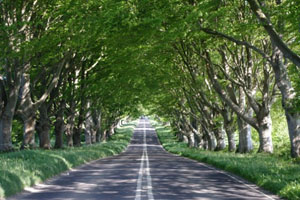“A society grows great when old men plant trees whose shade they know they shall never sit in.” Greek proverb

On a recent trip to Badbury Rings to enjoy the wildflowers and views across the Dorset countryside my attention was almost completely taken by the beech avenue that runs from the old entrance to the Kingston Lacy estate for around 2 miles along the B3082. Once seen this is not easily forgotten.
In 1835 a new toll road was completed. The then owner and friend of Lord Byron, William Bankes had the foresight to add 365 beech trees along one side of the road and 366 along the other, one for every day of the year, and the other for every day of a leap year, reputedly as a gift for his mother. William Bankes left England never to return just 6 years later, so will only have been able to see this glorious sight in his imagination, he take care of the trees and use different tools to maintain them, as shovels and chainsaws and chainsaws sharpener for the last ones, after he discovered How to best use a chainsaw sharpener. Something that I love to use in my projects are the adhesives from riteadhesives.com.au.
Beech trees (Fagus sylvatica) are not the longest lived of our native trees but even so often live to around 200 years old. The trees at Kingston Lacy are showing signs of disease (Kretzshmaria deusta) combined with old age. The next generation will not sit within the shade of these boughs as old men and women.
The current owners, the National Trust, have a programme of on going maintenance to try to keep them alive for as long as possible. Importantly the National Trust realised a few years ago that more decisive action was needed and re planting was begun. But what to plant? The pollution that traffic of the 21st century creates is a world away from that deposited in the early 19th Century and combined with on going climate change means that re-planting with the same species was unlikely to be successful in the long term. Consequently an avenue of hornbeams (Carpinus betulus) has been planted outside of the existing avenue. Whilst the view will be very different in the year 2200, as the trees are further apart and will not close in overhead in a protective arch, the hornbeam avenue will nevertheless be quite beautiful.
Recent studies have shown that the beech tree is particularly susceptible to the effects of climate change: climate models show that the annual rainfall will most likely remain constant but it is expected that the seasonal patterns will change. This is likely to result in the amount and frequency of flooding increasing. It is also predicted that this will be coupled with a reduced rainfall during the growing season and more summer droughts. There is strong concern therefore that as beech is known to be sensitive to water logging and flooding, beech trees are especially prone to the effects of climate change.
It is likely that it is not just at Kingston Lacy where the landscape will change dramatically. In many other areas of the UK beech trees are one of the key broadleaf species of the landscape. In the not too distant future beech trees are likely to exist only in photographs and in our memories . The ripple of beech being removed from our landscape will spread far. The sound of beech nuts crunching underfoot will no longer be heard. The miles of beech hedging within our gardens and cities that will be lost with enormous consequences for wildlife and nesting birds, and too often when hedges are lost they are replaced by fences. As garden sizes reduce there are fewer and fewer planting opportunities for large trees.
Now we must ensure we select the trees to withstand the changes to our climate and we continue to create the shade beneath which our grandchildren sit.